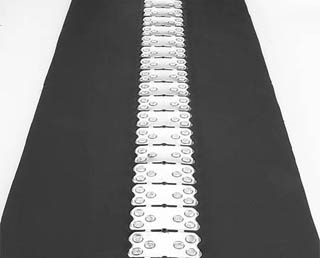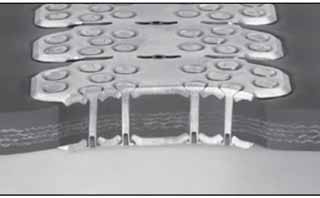Joining a Straight-Warped Belt – Why Rivet-Style Fasteners Work
If you are working in a demanding application with high-impact, tear resistant belting, there’s a good chance you’re working with a straight warp belt carcass. Straight warp fabric contains basic tension-bearing warp yarns, combined with interwoven binder cords. Straight warp belts are most commonly used when conveying heavy and/or large materials such as timber, stone, or sand and gravel.
Belt joining challenges
 While straight warp belting is useful in these applications, some issues arise when joining the belts together during splicing. Bolt-style fasteners, while fast and cost-effective, can create a lower fastener retention when the straight warp weave material is punched out for placement of the bolts. This is a result of the combination of: 1. A different weave type and 2. Less surface area of carcass to help provide resistance strength with the bolt when compared to conventional multi-ply belting.
While straight warp belting is useful in these applications, some issues arise when joining the belts together during splicing. Bolt-style fasteners, while fast and cost-effective, can create a lower fastener retention when the straight warp weave material is punched out for placement of the bolts. This is a result of the combination of: 1. A different weave type and 2. Less surface area of carcass to help provide resistance strength with the bolt when compared to conventional multi-ply belting.
Another option, vulcanization, is successful at maintaining a strong splice, but is often costly and time-consuming. Also, a trained professional and specialized equipment is required for the vulcanization process, which is especially inconvenient in an emergency repair situation. Time spent waiting for that professional to arrive and the actual vulcanization process is downtime that you can’t afford.
Benefits of the Rivet-Style Fastener
The optimal solution to these belt-joining issues is the rivet-style mechanical fastener. Installation of a rivet splice not only saves both time and money, but also maintains the strength of the belt. Here’s how it works: instead of displacing carcass material during installation, staggered, multiple-point rivet attachments pass between carcass fibers, separating them and maintaining the integrity of the belt for maximum resistance to pull-out. The staggered, multipoint attachment also provides a strong, long-lasting hold when combined with the low-profile, compressed plates.
Hinged or solid plate – does it make a difference?
Rivet fasteners are available in hinged and solid plate varieties. The rivet-hinged style of fasteners are ideal for use with portable conveyors and on conveyors with smaller pulley diameters. Solid plate rivet fasteners, on the other hand, are ideal for heavy-duty applications, especially ones that utilize straight warp belting. This recommendation is based on their durability and because the solid plates discourage materials from sifting through the splices.
New, smaller-style rivet plate fasteners are now available for those looking for a more cost-effective solution. They offer the same benefits as a larger fastener, including durability and abrasion resistance, and they work on smaller pulley diameters that still require a fastener for higher-tension applications (up to 400 P.I.W. or 70 kN/m).
So now that we know that a rivet solid plate fastener is best for these high-tension belts, here’s a quick checklist of things to look for when choosing a rivet solid plate fastener:
- Compatibility with high-tension applications
- Staggered pattern of self-setting rivets to ensure maximum belt grip
- Broad width and heavy gauge of plates for extended wear life
- Low-profile design to eliminate high spots or edges that might hang up on the belt
- Available in a variety of metals to suit the toughest of applications.
 Flexco has a large selection of rivet solid plate fasteners, for belts with thickness ranges from 3/16” to 15/16” (5 mm to 24 mm) and P.I.W. ratings from 400 to 800 P.I.W. (70 to 140 kN/m). The specially-shaped head of each pilot nail works with the installation tool’s anvil plate to “self-set” the rivets when splicing. Whether you are using a hammer our power tool, the same action that drives and sets the rivets, also tightly compresses the fastener plates for the strongest possible splice.
Flexco has a large selection of rivet solid plate fasteners, for belts with thickness ranges from 3/16” to 15/16” (5 mm to 24 mm) and P.I.W. ratings from 400 to 800 P.I.W. (70 to 140 kN/m). The specially-shaped head of each pilot nail works with the installation tool’s anvil plate to “self-set” the rivets when splicing. Whether you are using a hammer our power tool, the same action that drives and sets the rivets, also tightly compresses the fastener plates for the strongest possible splice.
The BR6 rivet solid plate fastener is a smaller plate fastener, making it ideal for small pulley diameters and a great choice for straight-warp belting applications. Installation is fast and simple, requiring only an installation tool base and a hammer or power tool to drive in rivets. The BR6 is also available in a variety of metals, including galvanized steel, stainless steel, RustAlloy®, and MegAlloy® for abrasive and corrosive environments, as well as Everdur for spark-free, non-magnetic performance.
If you aren’t sure which of our rivet fasteners are best for your application, utilize our Help Me Choose tool on the Web site for easy selection.
Authored by: Aaron Rosso, Senior Product Manager
Rosso is responsible for managing the heavy-duty mechanical belt fastener program globally for Flexco, including the program vision and strategy, product development plan, product line portfolio, promotion, PR and communications, pricing, and profitability. Rosso graduated from Western Michigan University with a bachelor’s degree in Finance and received his master’s degree in business administration from the Kellogg School of Management at Northwestern University with a concentration in Marketing and Strategy.
Subscribe to the Flexco Blog
Related Blogs
Published Date
May 22, 2019Product Group
- Mechanical Belt Fastening Systems
Issues
- Belt Wear
- Downtime
- Maintenance